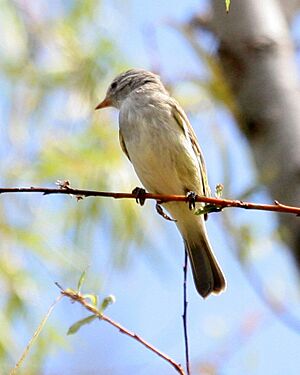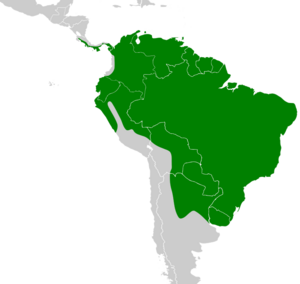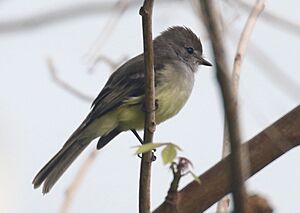Southern beardless tyrannulet facts for kids
Quick facts for kids Southern beardless tyrannulet |
|
|---|---|
 |
|
| Conservation status | |
| Scientific classification | |
| Genus: |
Camptostoma
|
| Species: |
obsoletum
|
 |
|
The southern beardless tyrannulet (Camptostoma obsoletum) is a small, active bird. It belongs to the tyrant flycatcher family. You can find this bird from Costa Rica all the way south through South America. It lives in countries like Paraguay, Bolivia, and Argentina.
Contents
What Does It Look Like?
The southern beardless tyrannulet is a tiny bird. It is about 10.2 centimeters (4 inches) long. It weighs around 7.5 grams (0.26 ounces). This bird often looks like a very small yellow-bellied elaenia.
Its head is dark brown or grey. It has a crest of feathers that can stand up. There is also a pale stripe above its eye, called a supercilium. Its back is grey-green, becoming lighter near its tail. The wings are brown with yellow edges on the feathers. They also have two bars that are whitish, yellowish, or cinnamon.
The tail is brown and often held pointing upwards. Its throat is grey, and its chest is yellowish. The belly is bright yellow. The bird's beak is black. However, the bottom part of the lower beak is usually pale.
Birds from wet places, like the Amazon basin, are often greener. They have bright yellow bellies. Birds from drier areas, like eastern Brazil, are usually greyer. Their bellies are not as bright. There is a special type, C. o. venezuelae, found only in Trinidad and Venezuela. It looks quite different in color.
Sounds and Calls
This bird makes a loud, clear whistle. It sounds like TLEEE-tee-tee-tee. When birds are trying to attract a mate, they raise their crests. They also flick their tails. They make an excited mix of the TLEE call and a churring sound. This churring sounds like pee-chrrr-pee-chrrr.
Both male and female southern beardless tyrannulets look similar. They always appear brighter than their close relative. This is the northern beardless tyrannulet (C. imberbe). They were once thought to be the same species. But they live in the same areas of central Costa Rica without mixing.
Where It Lives and What It Does
This bird lives in light forests and farms. You can also find it in gardens with trees. It likes dry cerrado savanna areas too. Southern beardless tyrannulets are very active birds.
What Does It Eat?
They eat insects, spiders, and berries. They hunt for insects and spiders in a few ways. Sometimes they fly out from a perch to catch prey in the air. Other times, they pick insects right off plants. They also eat fruit, like from the Alchornea glandulosa tree. They usually pick fruit while sitting or hovering in the air.
How It Behaves
These birds are known to "mob" small predators. This means they will gather together and harass them. An example is the ferruginous pygmy owl (Glaucidium brasilianum). This bird usually stays by itself. It only joins other birds during the breeding season. It rarely joins large groups of different bird species feeding together.
Life Cycle and Reproduction
The nest of the southern beardless tyrannulet is shaped like a dome. It is made from plant fibers or leaves. It has an entrance on the side. The nest is often placed in a tree fork. It is usually built near a wasp nest. This might help protect the bird's eggs from predators.
A typical nest has two white eggs. These eggs have reddish and purple marks, mostly at the wider end. The female bird sits on the eggs for 14 to 15 days until they hatch. After hatching, the young birds stay in the nest for about 17 more days before they can fly.
Conservation Status
This bird lives in a very large area. Because of this, the IUCN considers it a species of least concern. This means it is not currently at risk of disappearing.



